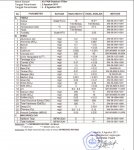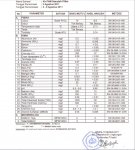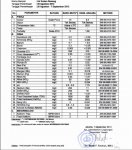Hi Gang,
I just got the lab report for my friend's pool. Same as my pool, it is tested to Drinking Water Standard to see all the stuff in it.
In my report : allright-tpf-alumni-changing-pool-water-in-real-time-t51352.html
I changed 50% of my water because it does not "taste" right.
I try to avoid changing all 100% of the water, if I can, for fear my pool will be lifted up by hydraulic pressure from ground water. I do have ground water under my 4 meters pool. I did see the water when it was constructed.
I am still wondering, what was it that I tasted and I find it not tasting right ?
One thing I am certain, my friends pool, a bigger one and less bather load ( no scuba divers ) taste better than my pool.
Forget PH, painful eyes and etc etc, I do not have such problem. What I am seeking is my pool water to be as fresh as possible like a bottled water.
I then opened up his water system file which I have with me, because in 2011, he requested to me to choose a filter system for his city and ground water supply.......to make it soft and super clean. He does not like staining from hard water and he has 1 shower system called the RainDance :
http://www.hansgrohe.co.uk/productdetai ... lang=en_UK
Its a very complicated shower system to mimic rain and elevate showering experience. However, learning from previous experience, hard water will cause clogging to the fine water jets.
So I was thinking , I could look into his files and learn where that "taste" I do not like about my water possibly comes from.
The notable improvement when I changed 50% water in my pool was the Chloride level. 700ish down to 500ish PPM.
So I googled about chloride and wanting to know why 250 PPM is the set limit ?
I found this :
http://www.wichita.gov/CityOffices/Wate ... formation/
" Chloride :
The suggested limit for chloride is 250 mg/l because some people can detect a salty taste when chloride exceeds 250 mg/l. Chloride has no physiological effect."
I am chemistry dummy. I tot sodium is salty but it is said ( google ) that 250 ppm sodium does not taste as salty as 250 PPM chloride.
I wouldn't say my pool water is salty in anyway, all I can say it does not taste as fresh as bottled water or as fresh as my friend's pool. I do experience better taste at 500ish PPM chloride compared to 700ish. So I can taste the difference. I mean 4 years I am into it so much everyday, I can tell if something is not perfect with my water or my expectation simply gets elevated each year I know more water 101.
My friend has an advantage that both his city water and ground water supply run thru his filter system, where I do not have that luxury. I do have a nano membrane filter system which I can use, but it serves my ground water only and not my city water supply and it is only 5,000 liters per day capacity. He only uses filtered/treated water to fill his pool. His filter system consist of ion-exchange, UV lamp, activated carbon and 1 micron filters. He has very very good raw water to feed his pool.
Here is his area city water suppy quality before being treated. See that it failed COLOR and Coliform. Well poor country, what da ya expect
[attachment=2:3ikb4smr]Direct from PAM ( city water supply ) not filtered - Aug 2011.JPG[/attachment:3ikb4smr]
Here is after passing thru the filter/treatment system.
Excellent result.
[attachment=1:3ikb4smr]PAM ( city water supply ) after filter system - Aug 2011.JPG[/attachment:3ikb4smr]
Here is his pool water test. It actually passed my country's Water Drinking Standard. And would probably pass World Health Org one too, but WHO one has Antimony, Silver, Selenium & tin listed where my country standard does not. Funny enough WHO does not mention TDS, or Hardness and some others. Well me chemy dummy anyway
http://www.lenntech.com/applications/dr ... ndards.htm
[attachment=0:3ikb4smr]Pool water test - Aug 2012.JPG[/attachment:3ikb4smr]
Please ignore chlorine level in the pool test. The lab seems to keep water sample so long that all 2 PPM CL water never get to be read higher than 0.5 PPM by them.
The main differences between his pool water compared to mine are :
- Chloride 210 vs 556 PPM
- TDS 828 vs 1215 PPM
- Total Hardness 93.5 vs 186 PPM
- MBAS 0.035 vs 0.05
QUESTIONS :
What are the other chemicals or whatever in a typical pool water which has a taste ?
I am tempted to buy drinking water by the trucks load if I have to, to replace my pool water. I doubt my city water if untreated can deliver good raw water. Investment in a filter system is possible but to make 135,000 liters ( will take weeks ), but where do I keep so much water ? Once in 2007 my city was flooded and my pool water was replaced because it too was flooded.
I actually did empty the pool 100% but it was only for a few hours.
The idea is simple. I don't mind spending US$1,500 - US$2,000 per two years to buy drinking water by the trucks to 35,000 US gallons. It is worth it. Bottle water cost so much is because of the bottling, marketing and so on, its real production cost is low because the brand I have in mind has mountain water source or artesian well.
http://www.aqua.com
The above company used to belong to my friend but now owned by the French Danone group. My friend may still have small share and I could possibly buy their water by the truck load.
Any ideas Gent ?
Many Thanks
.
I just got the lab report for my friend's pool. Same as my pool, it is tested to Drinking Water Standard to see all the stuff in it.
In my report : allright-tpf-alumni-changing-pool-water-in-real-time-t51352.html
I changed 50% of my water because it does not "taste" right.
I try to avoid changing all 100% of the water, if I can, for fear my pool will be lifted up by hydraulic pressure from ground water. I do have ground water under my 4 meters pool. I did see the water when it was constructed.
I am still wondering, what was it that I tasted and I find it not tasting right ?
One thing I am certain, my friends pool, a bigger one and less bather load ( no scuba divers ) taste better than my pool.
Forget PH, painful eyes and etc etc, I do not have such problem. What I am seeking is my pool water to be as fresh as possible like a bottled water.
I then opened up his water system file which I have with me, because in 2011, he requested to me to choose a filter system for his city and ground water supply.......to make it soft and super clean. He does not like staining from hard water and he has 1 shower system called the RainDance :
http://www.hansgrohe.co.uk/productdetai ... lang=en_UK
Its a very complicated shower system to mimic rain and elevate showering experience. However, learning from previous experience, hard water will cause clogging to the fine water jets.
So I was thinking , I could look into his files and learn where that "taste" I do not like about my water possibly comes from.
The notable improvement when I changed 50% water in my pool was the Chloride level. 700ish down to 500ish PPM.
So I googled about chloride and wanting to know why 250 PPM is the set limit ?
I found this :
http://www.wichita.gov/CityOffices/Wate ... formation/
" Chloride :
The suggested limit for chloride is 250 mg/l because some people can detect a salty taste when chloride exceeds 250 mg/l. Chloride has no physiological effect."
I am chemistry dummy. I tot sodium is salty but it is said ( google ) that 250 ppm sodium does not taste as salty as 250 PPM chloride.
I wouldn't say my pool water is salty in anyway, all I can say it does not taste as fresh as bottled water or as fresh as my friend's pool. I do experience better taste at 500ish PPM chloride compared to 700ish. So I can taste the difference. I mean 4 years I am into it so much everyday, I can tell if something is not perfect with my water or my expectation simply gets elevated each year I know more water 101.
My friend has an advantage that both his city water and ground water supply run thru his filter system, where I do not have that luxury. I do have a nano membrane filter system which I can use, but it serves my ground water only and not my city water supply and it is only 5,000 liters per day capacity. He only uses filtered/treated water to fill his pool. His filter system consist of ion-exchange, UV lamp, activated carbon and 1 micron filters. He has very very good raw water to feed his pool.
Here is his area city water suppy quality before being treated. See that it failed COLOR and Coliform. Well poor country, what da ya expect
[attachment=2:3ikb4smr]Direct from PAM ( city water supply ) not filtered - Aug 2011.JPG[/attachment:3ikb4smr]
Here is after passing thru the filter/treatment system.
Excellent result.
[attachment=1:3ikb4smr]PAM ( city water supply ) after filter system - Aug 2011.JPG[/attachment:3ikb4smr]
Here is his pool water test. It actually passed my country's Water Drinking Standard. And would probably pass World Health Org one too, but WHO one has Antimony, Silver, Selenium & tin listed where my country standard does not. Funny enough WHO does not mention TDS, or Hardness and some others. Well me chemy dummy anyway
http://www.lenntech.com/applications/dr ... ndards.htm
[attachment=0:3ikb4smr]Pool water test - Aug 2012.JPG[/attachment:3ikb4smr]
Please ignore chlorine level in the pool test. The lab seems to keep water sample so long that all 2 PPM CL water never get to be read higher than 0.5 PPM by them.
The main differences between his pool water compared to mine are :
- Chloride 210 vs 556 PPM
- TDS 828 vs 1215 PPM
- Total Hardness 93.5 vs 186 PPM
- MBAS 0.035 vs 0.05
QUESTIONS :
What are the other chemicals or whatever in a typical pool water which has a taste ?
I am tempted to buy drinking water by the trucks load if I have to, to replace my pool water. I doubt my city water if untreated can deliver good raw water. Investment in a filter system is possible but to make 135,000 liters ( will take weeks ), but where do I keep so much water ? Once in 2007 my city was flooded and my pool water was replaced because it too was flooded.
I actually did empty the pool 100% but it was only for a few hours.
The idea is simple. I don't mind spending US$1,500 - US$2,000 per two years to buy drinking water by the trucks to 35,000 US gallons. It is worth it. Bottle water cost so much is because of the bottling, marketing and so on, its real production cost is low because the brand I have in mind has mountain water source or artesian well.
http://www.aqua.com
The above company used to belong to my friend but now owned by the French Danone group. My friend may still have small share and I could possibly buy their water by the truck load.
Any ideas Gent ?
Many Thanks
.








 . Understood that you are a realist. Well, we all each have our own character.
. Understood that you are a realist. Well, we all each have our own character.